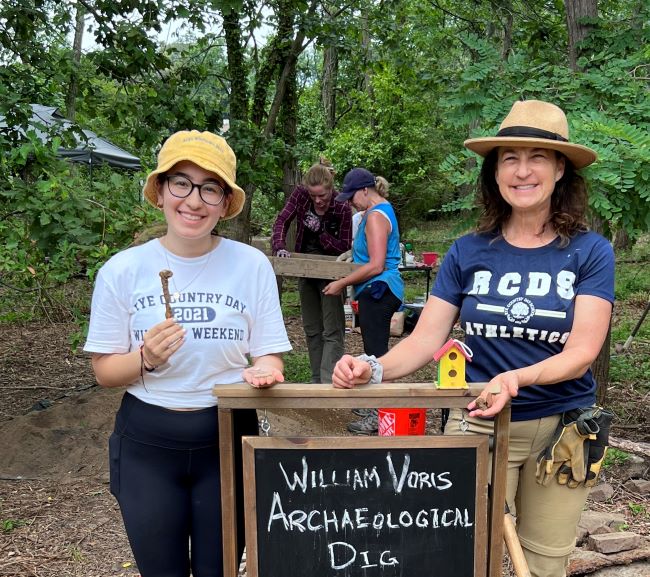Rosie Isiyel and Stephanie Victor, volunteer participants in the William Voris Archaeological Dig, on the grounds of the Rye Meeting House last summer.
- Photo courtesy of Sara Mascia
The Museum Association of New York announced that the Bird Homestead and Meeting House Conservancy’s program, the “William Voris Archaeological Site Excavation,” will receive a statewide Award of Distinction in the category of Community Engagement. The project took place during the summer on the grounds of the Meeting House and provided a hands-on learning experience focused on the life of William Voris, an African American entrepreneur in the 19th century. The Association will present the award at its annual conference in Syracuse next month. It is the only statewide museum service organization in the State of New York.
Archaeologist Dr. Sara Mascia planned and directed a series of eight community workshops open to anyone age 14 and up. Members of the public had a rare opportunity to work on a professional archaeological dig and learn about African American history in Westchester County. The program was supported in part by Humanities New York.
An 1868 map shows that William Voris owned two buildings. Unfortunately, neither stands today. His land is now included in the grounds of the Rye Meeting House. The deed states that he purchased the site in 1841, when it was unusual for African Americans to own property.
According to the 1870 census, William resided with his wife Jane, adult son John, and a 96-year-old woman named Martha Voris, likely his mother or aunt. Abraham Appleby, a waiter, and Mary and Jane Brown, waitresses, also lived in his household along with 6-year-old William Brown. The census lists William Voris as a “saloon keeper”. A saloon in the Northeast at the time was a restaurant or inn.
Participants learned and employed the techniques of archaeologists. Dr. Mascia, assistant archaeologist, Liz Eibert, and 12 volunteers worked each day to uncover numerous 19th-century artifacts. Most exciting, they found a section of the foundation of the 19th-century Voris house. Many people stopped by to watch the progress and ask questions.
The program revealed tangible evidence of the lives of William Voris and his household and recognized the people who lived and worked there. The lives of African Americans have frequently been omitted from mainstream historical narratives. The Conservancy wants to help rectify this omission with the Voris project. The program demonstrated that historical archaeology enhances the written record and leads to a fuller and more vivid understanding of the past.
“We were incredibly impressed with the quality and quantity of award nominations this year, which made the review process highly competitive,” said Clifford Laube, MANY Program Committee Co-Chair.
‘We are thrilled to receive this award and grateful to the Museum Association. We thank archeologists Dr. Sara Mascia and Liz Eibert and all the volunteers who helped with the dig,’ said Anne Stillman, president of the Conservancy. ‘We are committed to shedding light on the buried history of William Voris, his wife, Jane, and all the members of his household.’















